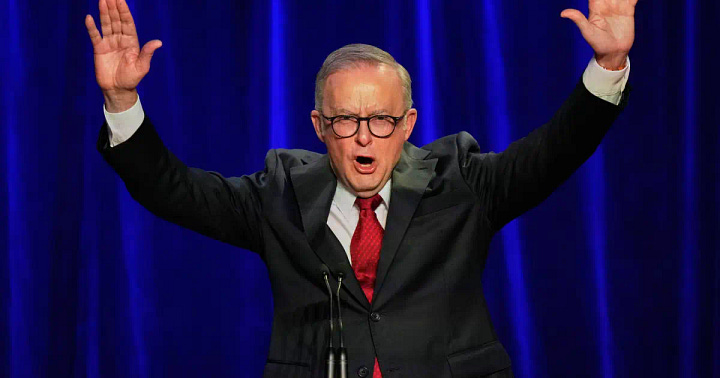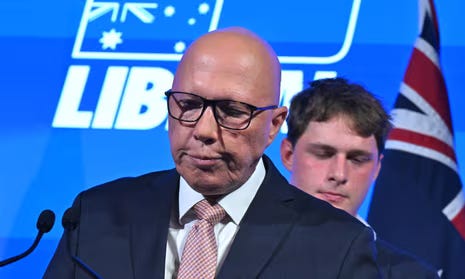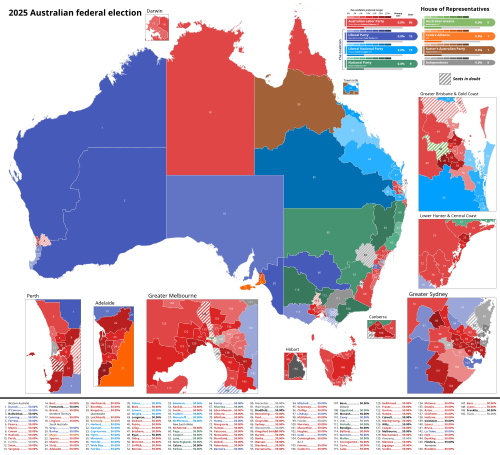The Right Goes Down Down Under
Australia Joins Canada In Giving It's Left-Wing Party A Stunning Turnaround Win


Less than a week after Canada went to the polls and delivered a stunning defeat to its right-wing, MAGA-curious party that had been on a path to victory just a few months ago, another Commonwealth country hit repeat.
Australians went to the polls on Saturday and gave a second term to their Labor government led by Prime Minister Anthony Albanese, which came to power in a 2022 election that ended the nine-year rule of Australia’s right-wing party, the Liberal Party.1 The results showed Labor will win far more seats than they need to form a government. Liberal Party leader, Peter Dutton, who just a few months ago was likely to become the next prime minister, will be ousted from Parliament altogether, losing his own district in Queensland.
If the results hold, Labor wins between 86 and 88 seats, at least 10 more than needed for a majority. It will be the largest for the party in its history, tied with or bigger than the 1987 reelection of former Prime Minister Bob Hawke, when Labor won 86 seats. It will be any party's most significant majority since Liberal Tony Abbott’s 2013 win.
What makes it even more shocking is that Albanese appeared to be headed for defeat just a few months ago. The same problems have beset his government as those of other left-wing leaders, like Joe Biden in the United States. They include struggling with uncertain and unstable economic conditions following the COVID-19 Pandemic, an angry and depressed left-wing base, and a moderate base that thinks the major parties are growing too ideological.
One of Albanese’s signature issues, an attempt to give the Australian Aboriginal population representation in Parliament from their own communities, failed in 2023 when 60 percent of Australians voted down a referendum that would have changed the country’s constitution to allow there to be seats in parliament for Aboriginal communities.
The failure angered Aboriginal voters, who were key to Labor’s 2022 win. The party also suffered from internal strife around protests over the War in Gaza. Jewish and Muslim voters, both vital to Labor’s coalition, both felt angry at Albanese for not taking a firmer stance on the war, antisemitism, and Islamophobia. The Green Party, hoping to supplant Labor as the main Australian Left-wing party, made Gaza central to their campaign, nominating candidates with radical views on the conflict.
Meanwhile, the Liberals and their coalition partners, the far-right National Party, focused on immigration and culture war issues, including opposition to transgender issues and racial equality, especially concerning Aboriginal rights. Their campaign followed a trajectory similar to that of right-wing parties in other countries, including the United States, post-pandemic.
By Autumn 2024, the Labor Party, which had led in polls since the 2022 election, fell behind the Liberal-National Party coalition. By the end of the year, they were solidly behind, though not in as big a deficit as Canada’s left-wing Liberal Party.
Then Donald Trump happened.
Trump’s unpopularity in Australia allowed Labor to make a case to voters that the country would need someone willing to stand up to Trump on the world stage, and not someone who might be ideologically inclined to bend the knee to him, like Dutton and his Liberal Party, who relied on support for the far-right, Trump-friendly National Party2. Domestically, Labor also promised to invest more money in the country’s health care system and reduce prescription prices, leading Dutton to say he’d do the same reactively.
As a result, the Liberal-National coalition’s five-point lead in polls for the two-party preferred vote evaporated, and by mid-March, Labor had taken the lead. By late April, they had the largest polling lead since Summer 2023.
Australia elects its members of parliament in a ranked choice system, like New York City will have for its Democratic primary for mayor next month, where voters rank their candidates. The top two finishers go to an instant runoff election, called two-party preferred, where the rest of the candidates’ supporters reallocate based on which of the top two candidates they ranked higher. If there are five candidates and Candidate B and D end up being the top two, then the voters who ranked Candidates A, C, and E have their votes reallocated to Candidates B or D, depending on which they ranked higher. This means that very often, the candidate who finished first in the primary does not end up winning. The Two-Party Preferred reallocation can take time, and the results are not finalized for over a week. However, it is already clear that Labor has won control of the government by a fairly large margin, regardless of how the close races pan out.
As of Sunday, counting is continuing, but the Labor Party is poised to pick up between 12 and 14 seats from the Liberals. They also picked off two Green-held seats.
Despite being in Dutton’s home state of Queensland, Brisbane has been integral in Labor’s win. Labor picked up at least six seats in Queensland from the Liberals, five in and around Brisbane. One of those districts was Dutton’s. He was defeated soundly in his district of Dickinson, northwest of Brisbane. Dutton joins Canada’s Peter Pollivere as the second right-leaning party leader to lose his seat in an election in a week. Labor also won two Green-held seats in Central Brisbane: the Brisbane constituency, including the city's heart, and the adjacent Griffith district. Labor also picked up the Division of Leichhardt in the northern tip of the state, which includes Cairns. Once a competitive area, Liberals have held the seat since 2010.
At least three seats in and around Sydney flipped to Labor, including Bennelong just north of Downtown Sydney. This district has some fascinating history. Former Liberal Prime Minister John Howard held it in the 1990s and 2000s, but he was defeated in 2007, one of the few sitting prime ministers to lose his district. Labor held it for one term before losing it in 2010, and the Liberals held on until this weekend.
In Victoria, where Liberals had hoped to leverage an unpopular Labor government, several Labor seats in Melbourne’s suburbs that were thought to be in contention just a couple of months ago ended up being landslide wins for the Labor incumbent. Two prominent Liberals lost their seats – Michael Sukkar, who would have served as Housing Minister in a Liberal government, and Keith Wolahan. Wolahan’s loss was shocking as his district of Menzies, located in Melbourne’s eastern suburbs, was once one of the safest in the country for the Liberals. Labor has never held it.
In the Division of Wills, a left-wing voting section of Melbourne heavily populated by immigrants, the Green Party’s Samantha Ratnam, who ran for the seat in 2016, tried again to oust Labor incumbent Peter Khalil. Anti-war voters have scorned Khalil for his role in working with the Iraqi provisional government after the Iraq War. He retained the district.
Labor is still in contention for the Green-held seat in Downtown Melbourne, held by Adam Bandt, the party’s leader. They are also still defending the Division of Bendigo, well north of Melbourne, where the far-right National Party has been ahead in the first two-party preferred allocations. Though Labor has held Bendigo since the 1990s, this is the part of Victoria where the backlash to the regional Labor government and progressive policies has been the strongest.
The Liberal Party also saw its fortunes collapse in Adelaide, which has increasingly become a Labor stronghold. The last liberal seat in Metro Adelaide, Stuart, fell to Labor.
Both Liberal MPs remaining in Tasmania lost their seats in upsets, leaving no Liberal member of Parliament on the once politically competitive island. Labor will hold all but one seat in Tasmania – that of Independent Andrew Wilkie of the Clark District in the state capital of Hobart.
In usually competitive Western Australia, Labor scored a big win, knocking off arch-conservative Independent –formerly Liberal – MP Ian Goodenough in the coastal suburbs north of Perth. However, Labor struggled in Perth’s eastern suburbs. In the Division of Bullwinkle in Perth’s eastern exurbs, a new seat that would’ve voted for Labor in 2022, the Labor candidate Trish Cook is up by less than 100 votes as of Sunday, with about 80 percent counted.
The results follow similar small swings toward Liberals in Perth's southern and eastern suburbs and exurbs, where mining and fossil fuel extraction are major industries and Labor’s environmental policies are unpopular with voters.
Independent Kate Hulett, who ran as a left-wing independent against Labor MP Josh Wilson in the safe Labor Division of Fremantle in Perth, is leading Wilson by about 200 votes in the latest two-party preferred count. However, it is believed this is due to the recent allocations from more left-wing parties, and Wilson should hold on. The race hasn’t been called.
In Labor-heavy Northern Australia and the Australian Capital Territory around Canberra, Labor won or is holding on to every seat. Only in the Division of Bean, in Canberra’s southwestern suburbs, is incumbent Labor MP David Smith struggling against a left-wing independent, Jessie Price. Price ran on a climate-focused agenda in an area that has been hit hard by wildfires and floods. Smith is ahead in the latest count.
Ultimately. Labor won the popular vote in every state except the Liberal stronghold of Queensland, but the Liberals are only ahead there by about a point. The popular vote swung to Labor in every state, most notably in Tasmania, where the swing was eight points from 2022.
While Australia’s Labor Party win may be a similar turnaround for the left-wing party as Canada, Labor had never been in the same level of trouble as Canada’s Liberals were. Also, while some political observers suggest it’s a sign that the post-pandemic defeats of incumbents may be waiting, Labor did not govern Australia during the pandemic; the Liberal Party under former Prime Minister Scott Morrison did. Labor’s 2022 win was one of the first examples of an opposition ousting an unpopular pandemic-era government. That the trend of the post-pandemic anti-incumbent wave may be vanishing may be a result of enough time passing since the pandemic, or it may be what everyone thinks it is – a global anti-right-wing wave brewing over the worldwide toxicity of the American regime.
In Australia, the Liberal Party is a right-wing party. In Canada, it’s the left-wing party. I don’t know, take it up with them.
In Dutton’s native Queensland, the Liberal and National parties merged.







Another democracy looks warily toward the US and says, "Nope, we don't want that shit."